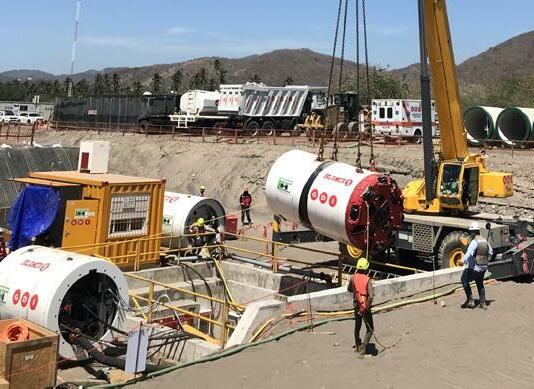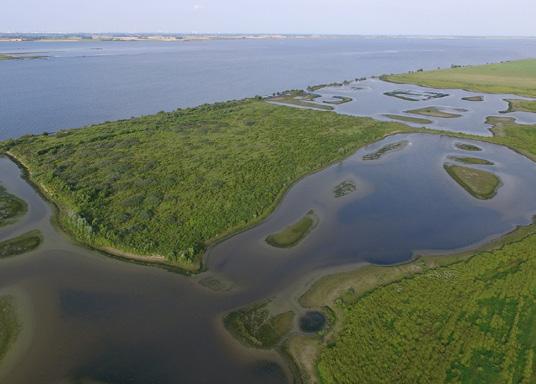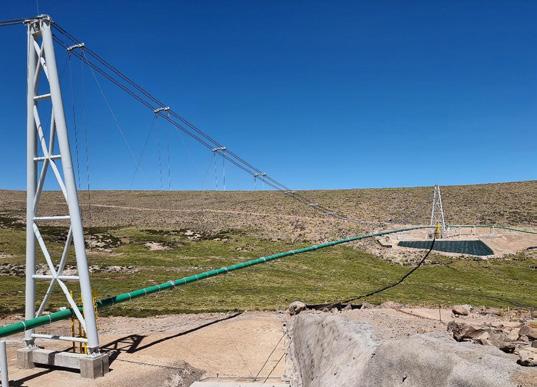
10 minute read
Member News
from IPLOCA Newsletter 92
by Pedemex BV
Bin Quaraya Co. Ltd Awarded Construction South Header LFDL, Saudi Arabia
Bin Quraya Co. Ltd has been awarded the contract to build a 63 km pipeline for the water injection trunkline junction at Lower Fadhili distribution to the central processing facilities plant Khurais in the Kingdom of Saudi Arabia. The project is divided into five segments with 3x8” nozzles and five tie-ins. Two major crossings with horizontal directional drilling (HDD) with 20” casing sleeve comprise two government facilities of 150 m in length. The pipeline will be installed with 4x16” thrust anchors and 28 open cuts for the rig road, 27 underground pipelines and 23 overhead power lines. Bin Quraya will deploy three spreads of fully mechanised dual torch welding stations and two semi-automatics to complete the welding ahead of the 4th quarter of 2022. The pipes are coated externally and internally in three locations: fabrication shop, third parties and field crews displaying the company logistics and transportation capabilities.
The strategy to expedite the activities consists of double jointing strings along the corridor associated with a multiple crossing strategy in order to save time and idle resources. The integrated management system recently implemented allows the construction teams to receive real data online optimising the field and quality teams in terms of communications, request for inspections, welding books, statistics, localisation, safety and environmental records.
GDI Develops Microtunnel in ManzanilloGuadalajara Pipeline
GDI is proud to have supported TC Energy by developing a microtunnel (MT) in the Manzanillo-Guadalajara Pipeline as a result of integrity campaigns of TC Energy. The microtunnel was successful for three main factors which allowed for reliable drilling execution. First, due to demanding characteristics of heterogenous soil with sands, gravels and boulders, specialised electrical tomography studies were carried out during the engineering phase that resulted in a validation proposed design. GDI implemented an effective equipment selection of a tunnel boring machine (Blanca 1) aligned with the

geological extreme conditions and safety parameters in trenchless activities. Third, a proper selection of concrete pipes was supplied locally with defined tolerances during their fabrication. Once the microtunnel was finished, mechanical activities with string prefabrication, product pipe pulling inside the microtunnel, testing and interconnection golden weld with the existing pipeline were done with the highest quality parameters.
The project was developed in a record period considering that all work site activities were completed between rainy seasons as was established in the safety plan.
Goriziane E&C S.p.A. has recently manufactured a new Internal Line-up Clamp (ILC). These ILCs are ready for final assembly and factory acceptance testing (FAT) before delivering them to onshore and offshore pipeline projects. The ILCs are built to accurately align pipe diameters ranging from 6’’ to 60’’ and even bigger, depending on customers’ requirements. Goriziane’s ILC has a modular design, thus it can be adapted for various applications (onshore or offshore) by adding a copper shoes system; high-force re-rounder; purging system; dedicated pads for internal coating or stainless steel pipe (CRA kit); a motorised system (for pipe OD > 16); emergency braking system; J-Lay Anchor module; winch; wireless remote-control; and visual laser and 3D camera system. In addition, Goriziane also offers a fully electric ILC with compact design where space is limited.

ILF Consulting Commissioned for ETL in Germany

Gasunie has commissioned ILF Consulting Engineers as general planner for the Energy Transmission Lines (ETL) 179 and 182. These pipelines are related to the LNG terminals in Germany, which are now needed more than ever, and serve on the one hand to connect the terminal in Stade to the grid and on the other hand to adapt the performance of the grid to the new conditions. ILF will carry out these projects as general planner from the completion of the feasibility study to the commissioning.
ISCO Helps Bring Safe Shores and Reliable Electricity to Rwanda
Through engineering and ingenuity, several companies were able to help turn a potentially disastrous problem into a powerful solution in Rwanda, where natural resources are limited. The country sits on the shores of Lake Kivu, which contains enormous amounts of dissolved carbon dioxide gas, trapped with methane, by the pressure of the water above. Shema Power Lake Kivu Limited (SPLK) secured the rights from the Rwandan government to extract this methane to fuel a new gas-to-power generation plant in the Rubavu District, thereby minimising the potential for a deadly disaster (should the enormous quantities of carbon dioxide leak into the atmosphere).
Texas-based oil and gas engineering company, Antares Offshore, was contracted by SPLK to present engineering

solutions for the project. ISCO Industries’ sales and technical engineering groups provided technical expertise on the physical properties and performance attributes of HDPE, which was chosen for the pipe, fittings and fabricated components, due to its long-term, corrosionresistant piping solution.
The Kivu-56 project is positively impacting both the economy and local inhabitants, providing reliable, green electricity and safer lakeside existence. Many local residents are included in the construction of the gas extraction barge and power plant, resulting in earned income and new job skills. Also, local companies in agriculture and tourism will have consistent electricity to power their businesses, allowing for greater output and export potential.
Seal for Life’s Stopaq Total Solutions
In 2021 Seal For Life (SFL) completed a year long gas pipeline project in Croatia utilising a number of SFL products to provide a total protection solution. The work was conducted on the new connecting main gas pipeline Zlobin - Omišalj DN800/100 for the LNG Terminal Krk. At the crossing under the railway near Zlobin and the crossing with state road D102 (Island Krk), the DN800 pipe runs inside DN1200 casings. The end user Plinacro d.o.o. wanted to secure the pipeline by filling the casings with Stopaq® Casing Filler which showed to be a more effective and reliable solution for corrosion protection compared to conventional methods. There were various challenges for application due to the difficult approach to the filling station, but they were overcome due to noteable collaboration between SFL’s personnel and the contractor.

The project also included field joints, bends, flanges and risers throughout. In addition to Casing Filler being used, Stopaq Wrappingband and Outerwrap were utilised and, due to the rocky areas, the company also added Outerglass Shield at field joints and SFL RockShield for the main pipeline that runs underground, subsea and above the ground.
Further Awards for Streicher’s Fully Electric Driven Horizontal Drilling Rig

Since winning the 2021 IPLOCA New Technologies Award and being a runner-up for the 2021 IPLOCA Health & Safety Award, Streicher’s first fully electric driven horizontal drilling rig, the HDD80-E has recently won two further awards: German Innovation Award 2022 (Machines & Engineering category) and Red Dot Award 2022 (Product Design category).
The German Innovation Award honours products and solutions that distinguish themselves primarily through user-centricity and added value, compared to previous solutions. Above all, the high degree of innovation of the HDD80-E and the resulting ecological and economic advantages were taken into account. The Red Dot Award is the most popular design competition worldwide.
The fully electric driven HDD80-E won the Product Design category, due to its aesthetic and ergonomic design.
Moreover, the jury was convinced by the low noise level and the valuable contribution to environmental protection based on the fully-electric rig design. Currently the company’s portfolio of future-oriented and sustainable technical solutions of the label ecotec also includes an electric welding tractor (PW150-E). A smaller horizontal drilling rig with a thrust/pullback load of 45 tons (HDD45-E) is now in production.
Techint’s Sustainable Construction Amid Wetlands in Peru
Techint Engineering & Construction has built a 87-km pipeline to transport water to the Quellaveco mining plant in the south of Peru. Quellaveco is a 60/40 joint venture between Anglo American and Mitsubishi Corporation. The project includes 5 above ground stations and will provide water from the Titire River, unsuitable for human consumption, to one of the largest copper deposits in the world. However, located in the Andean area of Moquegua, 4,000m above sea level, the mine lies among high mountains with extremely steep slopes and plenty of wetlands. Known as ‘bofedales’, they are a crucial source of food, water, shelter, and nesting sites for wild animals and livestock. Wetlands are considered a highly fragile ecosystem due to climate change, prolonged droughts, and human intervention.
Aligned with the UN Sustainable Development Goals, Techint E&C implemented a management programme on-site to minimise impact: carrying out preconstruction survey through 87 km, developing engineering to lay the pipes with deviation of water courses (temporary surface and ground water drainage pipes); checks and monitoring performed to mitigate the likelihood of sediment building up as well as any other potential impacts on the structure of the wetlands, their water quality and quantity; and special equipment used to extract the vegetation (known as ‘champa’) and preserved as the pipeline is being installed. When building works are completed, ‘champa’ is restored. One of the most important technical challenges of the project was designing and developing a 190m bridge so that a 24” water pipeline could cross safely over these unique high Andean wetlands. The whole process was monitored on a monthly basis in order to assure a full recovery of the ecosystem which involved 27 ‘bofedales’, that are a key part of the life of local communities.


Xionggu Automatic Welding Machine Accelerates Welding Work on Section of Sino-Russia Eastern Pipeline Phase 3
The Nantong-Yongzhi section of the Sino-Russia Eastern pipeline phase 3 is a key oil and gas infrastructure project. After completion, it will realise the interconnection of the Sino-Russia Eastern pipeline, the 1st West to East pipeline, and the Shanghai branch of the 2nd West to East gas pipeline. It plays an important role in optimising energy and realising energy conservation and emission reduction in the Yangtze River Delta and various provinces and cities along the line.
The 1st lot of the project is contracted by Sichuan Oil Engineering & Construction Co., Ltd. (CNPC Group), of which the pipeline length is 34.1km, with a pipeline diameter of 1422mm, pressure of 10MPa, a wall thickness of 32.1mm and it is made with X80 steel. Two spreads of Xionggu pipeline automatic welding machines are used including two units of Xionggu internal welding machines and 10 stations of Xionggu dual torch external welding machines.
The dense irrigation channels, farmhouses and temperatures above 40 degrees℃in the area make construction more difficult. The contractor completed a total number of 100 joints in 6 days, with a qualified rate of 98%, supported by the Xionggu technical service team.









